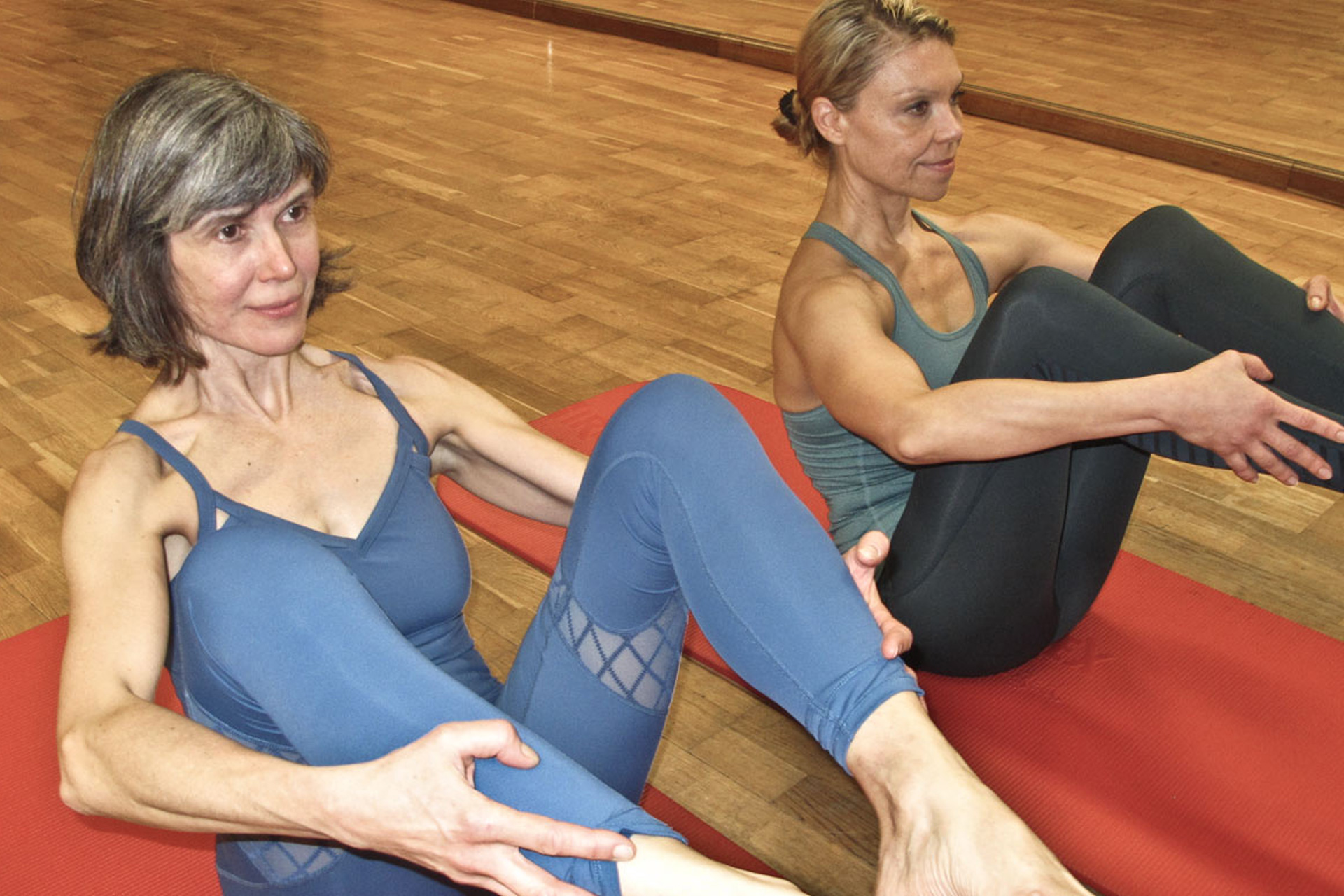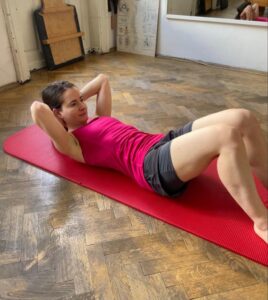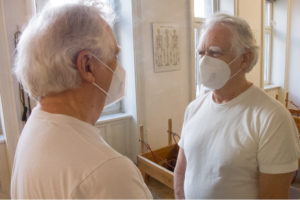Strategy and tactic
Our strategy: We roll upwards into the sky and not backwards down onto the ground.
Our tactic: We neuronally simply forget that the mat below us exists 😉
Rolling effortlessly like a ball
What prevents us from rolling our body effortlessly like a ball – apart from conditions like hyperlordosis and scoliosis – is the fear of falling. Whether this is perceptible to us or not is another story.
Sure, some people do the Rolling Like a Ball exercise naturally without ever having learned the technique, but many others don’t. If you are one of the latter, our blog post today is especially for you. Because only when we are not afraid of falling, we can roll effortlessly like a ball.
The first step to reduce our fear of falling is to learn to ‘ground’ our pelvis on the floor and in the air.
How do we ground our pelvis on the floor?

Sit on the mat with bent knees. Rock your sitting bones back and forth a few times. Then stop the movement just behind your sitting bones. Activate your powerhouse and bring your buttocks together using your hands and the pressing-squeezing-and-pulling technique. Then slide your feet off the floor without tilting your pelvis forward. That’s how you ground your pelvis on the floor!🙂
How do we ‘ground’ our pelvis in heaven?
Stay in this position and move your arms up and down. Hit them like in the Pilates Hundreds while bringing your knees closer to your torso. The flapping arms kinaesthetically tell you to connect your chest to your thighs before rolling back. Keep this connection, it is your grounding in the sky;)
The result is when rolling back you will use your powerhouse and shoulder girdle; not your upper back or head.
The difficulties of the Rolling Like a Ball exercise
Although the Rolling Like a Ball exercise is a basic Pilates exercise, it is difficult to understand and perform. It is also controversial in medical circles. Its function on our spine and intervertebral discs is always debated. We will come to that later.
What are the difficulties of the exercise based on?
- The human body is not round like a ball. Moving our body as if it were a ball requires a lot of knowledge and understanding of the body.
- The human body is not designed to move backwards. Therefore, any backward movement causes a certain degree of insecurity.
- In the starting position, our body has very little support. The fear of falling is so automatically triggered.
- The distance between the thighs and hip bones is challenging.

Balancing the difficulties
Let’s iron out the difficulties of the Rolling Like a Ball exercise by asking ourselves 3 essential questions:
- How can we move our body, which is obviously not a ball, as if it were a ball?
- At what point during the exercise do we need to implement some kind of ‘shock’ to maintain and control the dynamics of the movement?
- How can we counteract gravity when rolling in both directions?
Let’s look at the principle on which the Rolling Like a Ball exercise is based.
By the way, you can follow the entire blog post in our vlog right below. With many expressive pictures;)
What we see in the video and when?
0:08 Description of the Rolling Like a Ball exercise.
0:35 Difficulties with the Rolling Like a Ball exercise.
2:15 The principle of the Rolling like a Ball exercise – Control vs. momentum.
2:35 The ineffective way to do the Rolling like a Ball exercise.
3:30 The effective way to do the Rolling like a Ball exercise.
4:50 How do we overcome the difficulties?
The Rolling Like a Ball principle
Rolling like a ball means rolling with control instead of rolling by momentum.
The control comes from our power engine – our powerhouse – and not from our neck.
The ineffective way to roll: Momentum
Using momentum when rolling is ineffective. If we roll with momentum we mistakenly use our upper back when rolling down. When rolling back up, we then mistakenly initiate the movement from our head. This causes us to sink into our chest. You can see this well in the video from minute 2:35.
Rolling with momentum results in an unstable movement of our spine. It puts pressure on our intervertebral discs. This is also the reason why doctors and surgeons often claim that the Rolling Like a Ball exercise is bad for our back.
However, there is also a way of rolling that is a real benefit for our back.
The effective way to roll: Core control
Rolling effectively is only possible with our power engine – our powerhouse. This is because our powerhouse fixes our ribcage to our pelvis when we roll down. When we roll back again, it doesn’t let our pelvis tilt forward. Our pelvic bone does not move away from our navel.
The only power we need to control the roll is the power of our power engine. Our power engine creates core stability and core stability creates control when rolling. You can see this well in the video from minute 3:30.
What exactly does our power engine – powerhouse – do? Our powerhouse connects our pelvis to our ribcage as we roll down, and our shoulder girdle stabilisers to our glutes as we roll up. If you can make and maintain these two connections, then you can really roll backwards vertebra by vertebra. When you roll, there will be no empty space between your sacrum and the mat. You will then be able to easily stop the roll at any point.
Back to our 3 questions …
The magic of our powerhouse and shoulder girdle

1. How do we move our body, which is obviously not a ball, as if it were a ball?
Firstly, by activating our powerhouse together with our gluteal muscles before we start rolling. This brings our pelvis into a functional posterior tilt. Secondly, by gently pushing our ribcage down to our pelvis via our shoulder girdle stabilizers. This is how we create a convexity in our lower back. Voilà, our body ball!
2. At what point during the exercise do we need to implement some kind of ‘shock’ so that we can maintain and control the dynamics of the movement?
There are 2 places where the energy flow of the movement changes. On the way down, the energy increases. On the way up, the energy decreases. A controlled ‘shock’ must therefore happen at exactly these 2 interfaces where the energy flow changes. This is how we prevent the hard fall onto the mat on the way down, and a ‘getting stuck’ on the way up.
3. How do we counteract gravity when rolling in both directions?
We counteract gravity by using our power engine – powerhouse – and shoulder girdle stabilisers to connect our pelvis with our chest into a functional unit.
Try it & fly with it!
Did you like our blog post? Then kindly support us and share it on social media sites like Facebook, Twitter, group forums, blogs and – all the retro way – personally among friends. We also highly appreciate your feedback on our exercises and posts.




